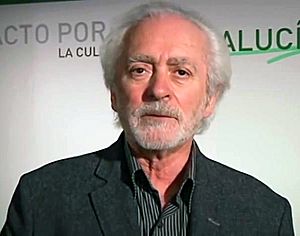Manolo Sanlúcar facts for kids
Quick facts for kids
Manolo Sanlúcar
|
|
|---|---|

Sanlúcar in 2013
|
|
| Background information | |
| Birth name | Manuel Muñoz Alcón |
| Born | 24 November 1943 Sanlúcar de Barrameda, Spain |
| Died | 27 August 2022 (aged 78) Jerez de la Frontera, Spain |
| Genres | Flamenco |
| Occupation(s) | Musician |
| Instruments | Guitar |
Manolo Sanlúcar (born Manuel Muñoz Alcón, November 24, 1943 – August 27, 2022) was a very important Spanish flamenco composer and guitarist. He is known as one of the most significant Spanish composers of recent times. Along with other famous guitarists like Paco de Lucía, Tomatito, and Vicente Amigo, he helped change and improve the flamenco guitar.
Contents
Who Was Manolo Sanlúcar?
Manolo Sanlúcar was a master of the flamenco guitar. He was born in Sanlúcar de Barrameda, Spain. His real name was Manuel Muñoz Alcón. He became famous for his amazing guitar playing and for writing beautiful music.
His Early Life and Learning
Manolo Sanlúcar learned to play the guitar from his father, Isidro Sanlúcar. His father was a baker but also a talented old-style guitarist. Their home was often filled with people who loved flamenco singing and playing music. Manolo was very skilled from a young age and quickly followed in his father's footsteps. His brothers, including Isidro, also became guitarists.
Blending Flamenco and Classical Music
Manolo Sanlúcar soon began to explore new ideas with the guitar. He realized the instrument had many possibilities that had not been fully discovered. His biggest goal was to combine flamenco music with symphonic (orchestral) music.
He created several important works that brought his name among great composers. These include:
- Fantasía para guitarra y orquesta (Fantasy for Guitar and Orchestra)
- Trebujena
- Medea (which toured the world as a ballet)
- Soleá
- Tauromagia
- Aljibe
These pieces showed his efforts to mix flamenco with classical sounds. He wanted people to see flamenco as a deep and complex form of music. He believed flamenco was a way of thinking and feeling for a whole culture. He wanted orchestras to play flamenco music, not just as an accompaniment, but to truly capture its spirit and magic.
Other Musical Projects
Sanlúcar also composed a type of flamenco opera called Ven y Sígueme. It was based on an idea by Lebrijano and was meant to be performed on stage.
Two of his most praised albums are Tauromagia (from 1988) and Locura de Brisa y Trino (from 2000). He also appeared in some films.
Awards and Recognition
In 2000, Manolo Sanlúcar received Spain's important Premio Nacional de Música (National Music Award) for his amazing performances.
Discography
Here are some of the albums Manolo Sanlúcar released:
- 1968: Recital Flamenco
- 1970: Inspiraciones
- 1971: Peineta Cubana
- 1971: Mundo Y Formas De La Guitarra Flamenca Vol. I
- 1971: Mundo Y Formas De La Guitarra Flamenca Vol. II
- 1972: Mundo Y Formas De La Guitarra Flamenca Vol. III
- 1975: Manola Sanlucar King of Flamenco Guitar
- 1976: Sentimiento
- 1977: Fantasía Para Guitarra Y Orquesta
- 1978: ...Y Regresarte (Homenaje A Miguel Hernandez)
- 1979: Manolo Sanúcar En Japón
- 1980: Candela
- 1981: Azahares
- 1982: Al Viento
- 1982: Ven Y Sigueme
- 1984: Trebujena
- 1985: Testamento Andaluz
- 1987: Medea
- 1987: Dos guitarras flamencas (with Sabicas)
- 1988: Tauromagia
- 1989: Solea
- 1992: Aljibe
- 2000: Locura De Brisa Y Trino
See also
 In Spanish: Manolo Sanlúcar para niños
In Spanish: Manolo Sanlúcar para niños

